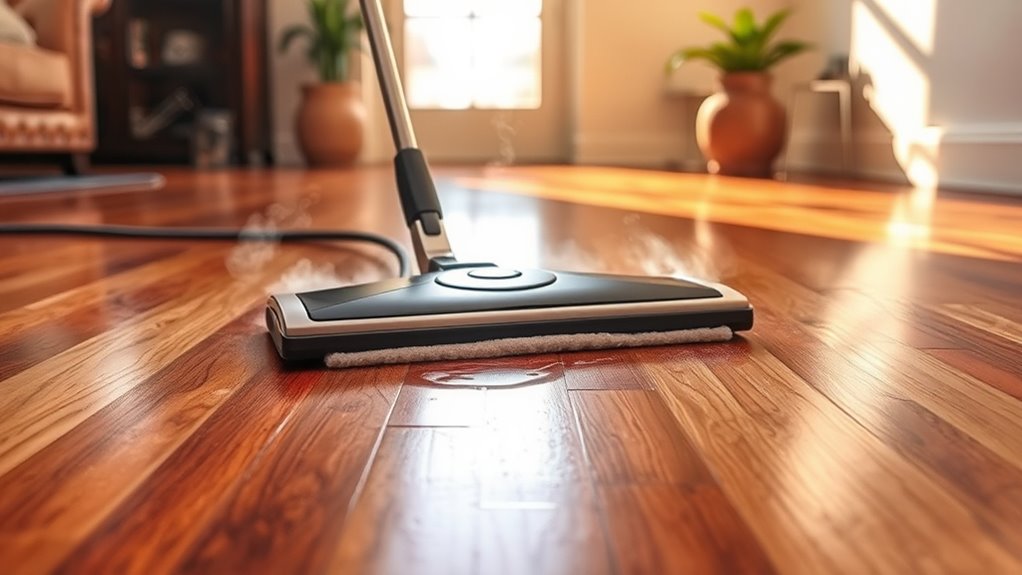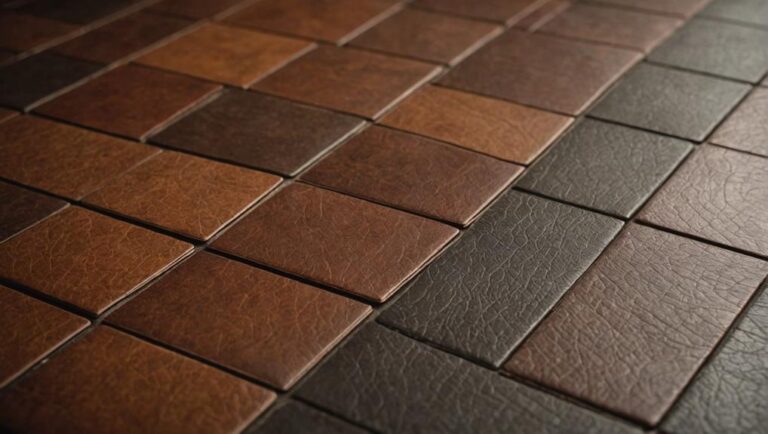You can use a steam mop on hardwood floors safely, but only with caution. Hardwood is sensitive to moisture and heat, so avoid excess steam and limit exposure time. Use the lowest steam setting, test a small area first, and move the mop quickly with microfiber pads to protect the finish. Also, make sure your floor is well sealed and always dry it afterward. Following these steps helps prevent damage, and understanding more details will guide you in keeping your floors in top shape.
Understanding Hardwood Floor Sensitivity to Moisture
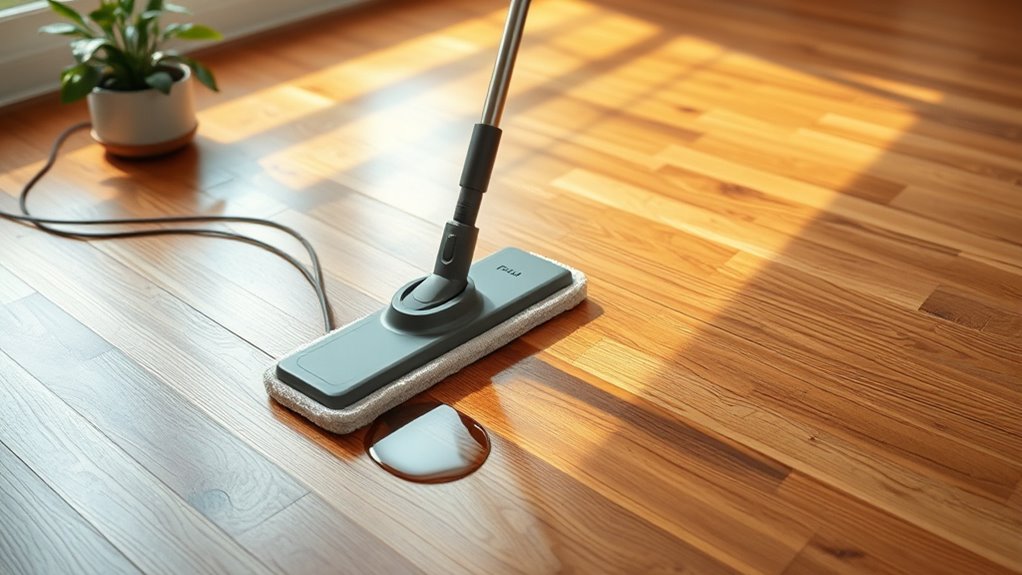
Because hardwood floors are made from natural wood, they’re particularly sensitive to moisture. When water or steam lingers, it causes moisture retention within the wood fibers. This moisture leads to wood expansion, which can warp, buckle, or damage the floor over time. You want to maintain your hardwood’s integrity while enjoying the freedom of easy cleaning. To do this, avoid excessive wetness and prolonged exposure to steam. Understanding how moisture interacts with wood helps you prevent costly repairs and preserve your floor’s beauty. Using cleaning methods that control moisture levels allows you to keep your hardwood floors in pristine condition without sacrificing convenience. Stay mindful of moisture retention and wood expansion to confidently care for your floors the right way.
How Steam Mops Work on Different Floor Types
When you use a steam mop, the device heats water to produce steam that loosens dirt and kills bacteria on your floors. This method offers excellent cleaning efficiency on floor types like sealed tile, laminate, and vinyl, where moisture tolerance is higher. However, floor compatibility varies because steam can penetrate surfaces differently. For instance, sealed floors handle steam well without damage, maintaining their finish and hygiene. Conversely, unsealed or sensitive floors, such as certain hardwoods, may absorb moisture, risking warping or discoloration. To maximize steam mop benefits, always check your floor’s specifications and adjust steam levels if possible. Understanding how steam interacts with each floor type guarantees you clean effectively while preserving your flooring’s integrity and your freedom to maintain a fresh, safe home.
Potential Risks of Using Steam Mops on Hardwood
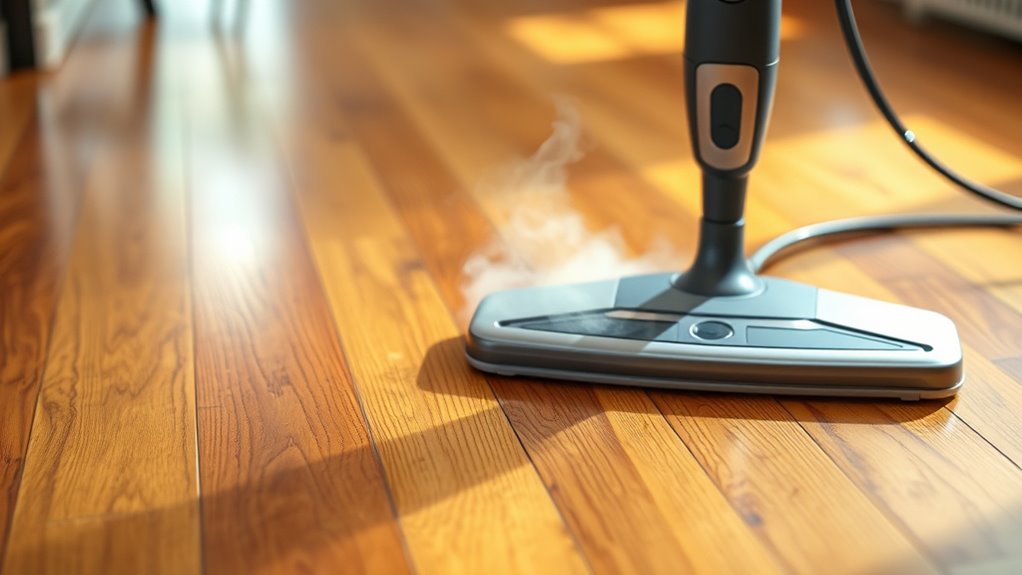
You’ll want to be cautious with steam mops on hardwood because excess moisture can seep into the wood, causing swelling or warping. The heat and steam might also damage the floor’s finish or break down its seal over time. Understanding these risks helps you decide if a steam mop is the right tool for your hardwood floors.
Moisture Damage Concerns
Although steam mops can make cleaning hardwood floors easier, they also pose significant risks due to moisture exposure. When you use a steam mop, moisture accumulation becomes a real concern because hardwood is sensitive to water. Excess moisture can seep into seams and cracks, causing the wood to swell, warp, or even buckle over time. To protect your floors, damage prevention is essential—avoid lingering steam on one spot and limit the use of steam mops to only well-sealed hardwood surfaces. Always check manufacturer guidelines before using steam cleaning. By controlling moisture exposure and ensuring quick drying, you can reduce the risk of damage and keep your hardwood floors looking great without sacrificing your freedom to clean efficiently.
Finish and Seal Risks
Since hardwood floors rely on a protective finish to maintain their appearance and durability, using steam mops can compromise that seal. When you apply steam, the intense heat and moisture can weaken the finish durability and damage the seal integrity, leading to costly repairs. Consider these risks:
- Finish Softening: Steam can soften or bubble the finish, making it vulnerable to scratches and wear.
- Seal Breakdown: Repeated steam exposure breaks down the seal, allowing moisture to seep into the wood.
- Discoloration: Heat and moisture may cause the finish to discolor or become blotchy over time.
To keep your floors looking their best and maintain freedom from frequent refinishing, avoid steam mops or use them only with extreme caution on hardwood surfaces.
Types of Hardwood Floors Compatible With Steam Cleaning
Not all hardwood floors handle steam cleaning the same way, so it’s important to know which types are safe. Engineered hardwood tends to tolerate steam mops better than solid hardwood, which can be more vulnerable to moisture damage. Also, the finish on your hardwood plays a vital role in protecting it during steam cleaning.
Engineered Hardwood Tolerance
When you’re considering steam mops for your hardwood floors, it’s important to understand how engineered hardwood tolerates moisture and heat. Engineered hardwood offers better durability than solid wood, thanks to its layered construction, but its steam mop compatibility varies.
- Top Veneer Quality: High-quality veneers resist moisture better, enhancing engineered hardwood durability during steam cleaning.
- Core Material: Plywood or HDF cores provide dimensional stability, lowering the risk of warping from steam exposure.
- Finish Type: A strong, sealed finish protects against steam’s moisture, making steam mops safer to use on certain engineered floors.
You should always check manufacturer guidelines. While engineered hardwood is more tolerant, improper steam mop use can still damage your floor, so proceed with caution to keep your floors looking great and lasting longer.
Solid Hardwood Risks
Although solid hardwood floors offer timeless beauty, they come with specific risks when exposed to steam cleaning. The hardwood composition—usually a single piece of wood—makes these floors highly susceptible to moisture damage, warping, and cupping. Using a steam mop can introduce excessive heat and water, which penetrates the wood and compromises its integrity. If you want to maintain your freedom to clean effectively without risking damage, consider steam mop alternatives like microfiber mops or damp cloths designed for hardwood. These options clean well without saturating the wood. Remember, solid hardwood isn’t typically compatible with steam cleaning, so choosing gentler methods helps you preserve your floors’ natural charm while avoiding costly repairs or refinishing down the line.
Hardwood Finish Importance
Since the finish on your hardwood floor acts as a protective barrier, its type plays an essential role in determining whether steam cleaning is safe. You need to understand hardwood finish types to avoid damaging your floors during steam mop use. Here’s what you should consider:
- Polyurethane finishes – These are durable and water-resistant, making them generally safe for steam cleaning if the mop is used cautiously.
- Wax or oil finishes – These tend to absorb moisture, so steam cleaning can cause damage and strip the finish, requiring more frequent finish maintenance.
- Aluminum oxide finishes – Found mostly on engineered hardwood, they offer excellent protection and tolerate steam mops better than natural finishes.
Knowing your hardwood’s finish type helps you maintain its beauty and longevity while deciding if a steam mop fits your cleaning routine.
Best Practices for Using Steam Mops on Hardwood Floors
If you want to keep your hardwood floors looking their best while using a steam mop, it’s vital to follow specific guidelines. Steam mop advantages include efficient dirt removal and sanitization, but incorrect use can damage wood. Use hardwood cleaning techniques that protect your floor’s finish and avoid excess moisture.
| Practice | Why It Matters | Tip for Freedom |
|---|---|---|
| Test small area | Prevents finish damage | Choose hidden spot first |
| Use low steam | Avoids warping wood | Adjust settings accordingly |
| Move quickly | Limits moisture exposure | Keep mop moving constantly |
| Use microfiber pad | Protects floor surface | Change pads regularly |
| Avoid harsh chemicals | Preserves finish integrity | Stick to water only |
Following these steps guarantees you enjoy the benefits of steam mops without sacrificing your hardwood’s beauty.
Alternative Cleaning Methods for Hardwood Floors
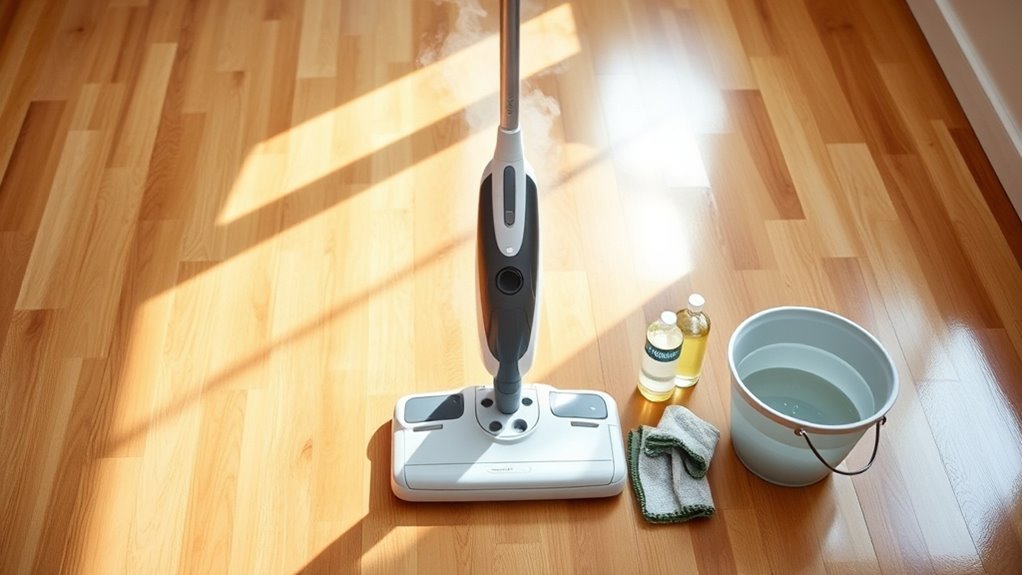
When steam mops aren’t the best fit for your hardwood floors, there are several alternative cleaning methods you can rely on to maintain their shine and durability. Here are three effective options:
- Microfiber Mop: Use a dry or slightly damp microfiber mop to pick up dust and dirt without risking water damage. It’s gentle and safe for hardwood finishes.
- Vinegar Solution: Mix a small amount of white vinegar with water (about 1 cup vinegar to 1 gallon water) for a natural cleaning alternative. Lightly dampen a mop with this solution to clean without harsh chemicals.
- Specialized Hardwood Cleaners: Opt for commercial hardwood floor cleaners designed to protect your floors while removing grime effectively.
These methods help keep your floors clean and free from moisture-related harm, giving you freedom from worry about damage.
How to Prepare Hardwood Floors Before Steam Mopping
Before you start steam mopping, you’ll want to thoroughly prepare your hardwood floors to prevent damage and secure effective cleaning. First, remove loose dirt and debris by sweeping or vacuuming with a soft brush attachment. Avoid harsh cleaning products that can strip the floor’s finish. Use gentle, pH-neutral cleaners if needed. Check for any floor protection measures like rugs or furniture pads; remove or adjust them to steam mop all exposed areas evenly.
| Step | Action |
|---|---|
| 1 | Sweep or vacuum thoroughly |
| 2 | Avoid harsh cleaning products |
| 3 | Use pH-neutral cleaning products |
| 4 | Remove or adjust floor protection |
Proper prep secures your floors stay safe while you enjoy a fresh, clean surface.
Recommended Steam Mop Settings for Hardwood Floors
Once your hardwood floors are properly prepared, setting the steam mop correctly will help you clean effectively without causing damage. Choosing from recommended steam mop brands that offer adjustable settings is key. Look for ideal steam mop features like variable steam control and gentle fabric pads. Here’s how to set it up:
- Start with the lowest steam setting to avoid excess moisture that can warp wood.
- Use the mop’s gentle or hardwood-specific mode if available—this guarantees maximum heat and steam levels.
- Move the mop slowly and evenly to allow the steam to loosen dirt without saturating the floor.
Signs Your Hardwood Floor May Be Damaged by Steam
If you notice visible warping or cupping on your hardwood floor, it could be a sign of steam damage. Discoloration, stains, or unusual marks might also indicate moisture issues from steam mopping. Additionally, peeling or bubbling on the surface suggests the finish is compromised and needs attention.
Visible Warping and Cupping
Though steam mops can be effective for cleaning, they often cause visible warping and cupping on hardwood floors, which are clear signs of moisture damage. When steam penetrates the wood, it disrupts the natural moisture levels, causing the boards to expand unevenly. You’ll notice:
- Warping – boards bend or twist out of shape, ruining the flat surface.
- Cupping – edges of the boards rise, creating a concave shape that’s uncomfortable to walk on.
- Gaps – as the wood dries unevenly, gaps may form between planks, weakening floor integrity.
To protect your floors, control moisture levels carefully and stick to proper floor maintenance methods. Avoid steam mops if you want to preserve your hardwood’s natural beauty and durability.
Discoloration and Stains
Because steam introduces excessive moisture to hardwood floors, you might notice discoloration and stains developing over time. These discoloration causes often stem from the wood absorbing water vapor, leading to dark or white patches that disrupt the floor’s natural finish. If you spot such stains, it’s essential to act quickly—delaying stain removal can make damage permanent. Using gentle cleaning solutions designed for hardwood can help minimize discoloration, but steam mops may worsen the issue by driving moisture deeper into the wood. To maintain your floor’s freedom and beauty, consider alternative cleaning methods that avoid excessive moisture. Recognizing early signs of discoloration and addressing them promptly guarantees your hardwood floors stay vibrant and intact without risking further damage.
Surface Peeling or Bubbling
When steam penetrates your hardwood floors, you may start noticing surface peeling or bubbling—clear signs that moisture is compromising the wood’s integrity. This type of surface damage indicates that steam cleaning techniques are too harsh for your floors, potentially leading to costly repairs. To prevent this, consider:
- Limiting steam exposure time to avoid excessive moisture buildup.
- Using a steam mop with adjustable settings designed specifically for hardwood floors.
- Opting for alternative cleaning techniques like damp mopping or specialized hardwood cleaners.
Maintaining Hardwood Floors After Steam Cleaning
After using a steam mop on your hardwood floors, you’ll want to confirm they stay in ideal condition by promptly addressing any residual moisture and applying proper care techniques. For effective post steam maintenance, immediately wipe down the floors with a dry, soft cloth to prevent water from seeping into the wood. Avoid leaving dampness that can lead to warping or staining. Additionally, consider applying protective treatments such as specialized wood floor oils or sealants to reinforce the surface’s resistance against moisture. These treatments help maintain the floor’s finish and extend its lifespan. Regularly inspect your flooring for any signs of damage, and always follow manufacturer guidelines for both your steam mop and hardwood floors. Staying proactive confirms your floors remain beautiful and durable without compromising their integrity.

